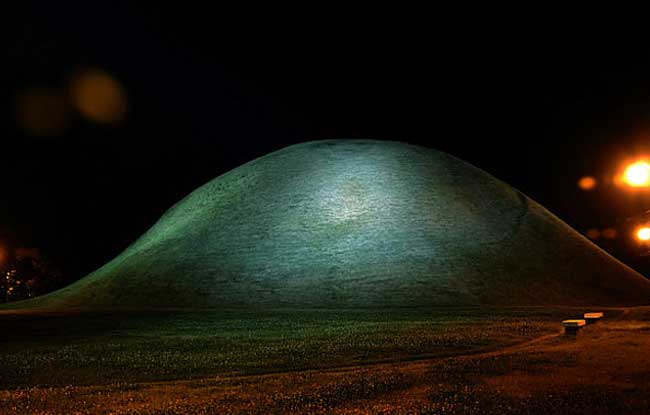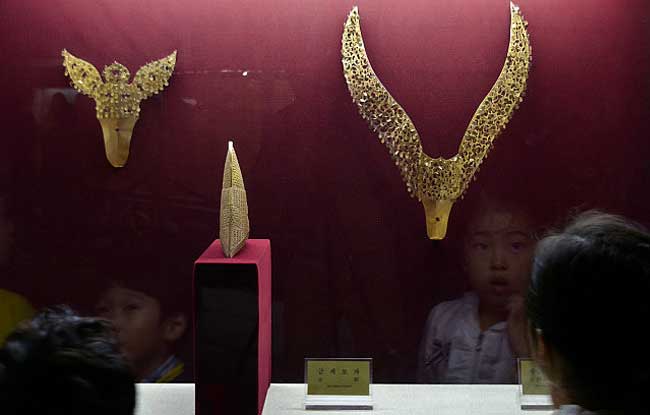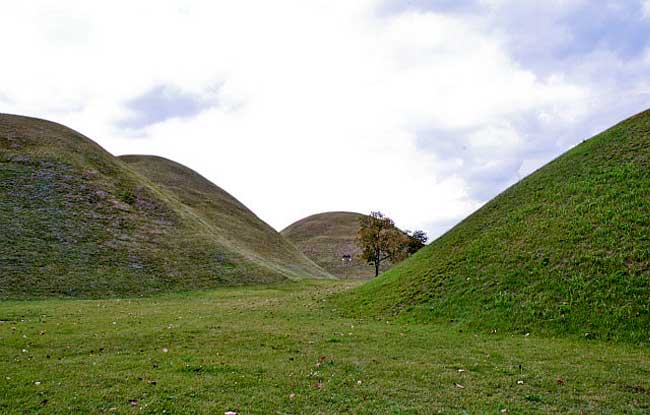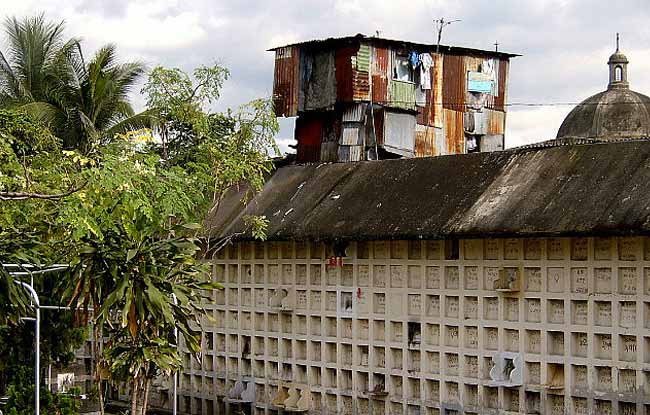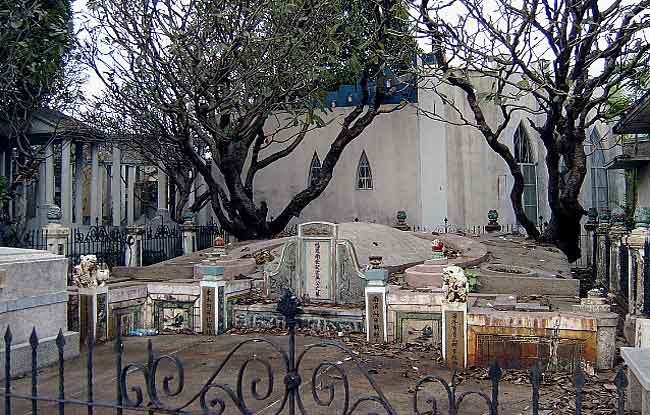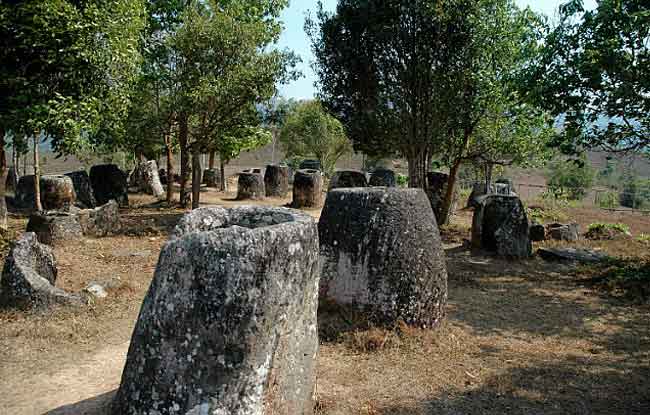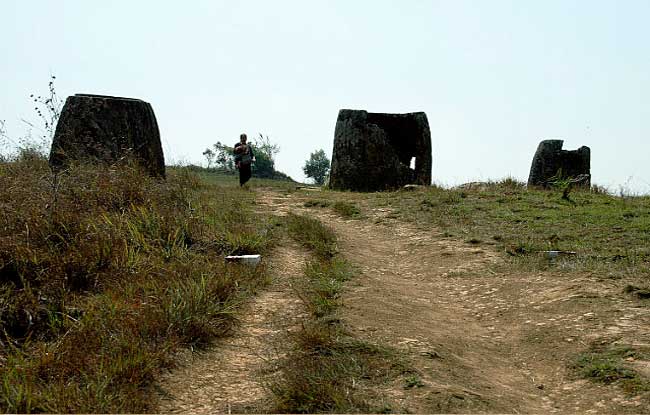We all die. What happens then varies with culture, status and time. I like to visit burial grounds, because they demonstrate people's ideas about the life hereafter. Europe has beautiful cemeteries, of which the Cimetière du Père-Lachaise probably is the most famous. Here are three sites that are a bit different from those in the Western, Christian tradition.

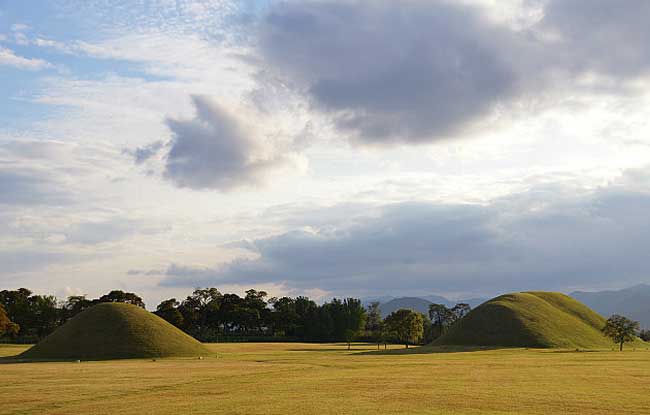
Intriguing Burial Grounds
Smack in the centre of Gyeonju, a city close to the coast in the south-eastern corner of South Korea, are 23 tombs of the royalty of the Shilla monarchy, one of the three kingdoms reining Korea around our year zero. They are tumuli, huge mounds of rocks and earth that cover a burial chamber each. Here the round hillocks are covered with grass, some about 15 meters high and 50 meters in diameter, and they look extra-terrestrial. Especially at night when the surroundings resemble a UFO landing strip and you can almost hear the buzz of the refuelling, cargo loading en pre-boarding procedures. There are more tumuli groups in the world - for example in Upsala, Sweden - but this one is remarkable because the mounds here are so beautifully shaped and well preserved. There is no doubt that they are not coincidental hills, but man-made. Their surface is smooth, their outline almost voluptuous, especially the ones that merge into each other into a gourd form.
The centre part of the area is a fenced park for which you have to pay an entrance fee. Its importance is in the number of tumuli. One of them, Cheonmachong, was excavated in 1973 and is made into a museum in which some of the treasures, found in that tumulus, are on display, among which a golden crown and headgear, a sword, household utensils and a painting of a Korean Pegasus (Cheonma) on birch bark. The exhibit also shows how the tumuli are built: a rectangular chamber, lined with wood, filled with sand and covered with boulders and impermeable clay.
But the most exhilarating experience is walking between these grassy mounds and admiring their curves and the space in between and imagining another spaceship to land very soon with alien royalty aboard. And that sensation is better felt at the two other, open sites. It helps that at the edge of the third park there is the oldest existing astronomical observatory in Asia: Cheomseongdae.
With one entrance set at the Aurora Boulevard it seems like the Chinese cemetery of Manila is supposed to rather be a starting point of the afterlife than the end of an earthly abode. Nevertheless, the remains of the human body are taken good care of in these places one can really call a resting place. A visit of the surviving relatives is always reasonably comfortable in all kinds of weather, simply because the graves are fairly large buildings in which you can hide from the scorching sun or the pouring rain, escape from the heath in the air-conditioned rooms. It's not sure whether the kitchens, running water and toilets are meant for the visitors or for the deceased, who need such commodities in their after live, of course. Anyway, the people who are hired to take daily care of the tombs and live on the premises gladly make use of them. Sometimes stealthily, sometimes with the owner's consent.
If you go there to take a look, be luckier than we were: we couldn't find a guard at that time to show us the gaudiest abodes of the cemetery. By the way, they charge you to do that. But the best days to go there are November 1st and 2nd: All Saints Day and all Souls Day, when loads of Philippine Chinese come to visit their ancestors, offering them flowers and food.
Even if you can't afford to buy a villa, you can get a final resting place in the wall, if needed.
Visitors of Laos used to skip the Plane of Jars, because it was quite a detour from the trodden path from Vientiane via Van Vieng and Luang Prabang and then by boat over the Mekong to the Thai border crossing at Huay Xai. Traveller's itineraries change rapidly and in this case rightly so, because the Xieng Khouang plateau experience is one of magic and bewilderment.
Thousands of stone jars are scattered in the landscape, most of them in clusters and on hilltops with a commanding view of the surroundings. They are mainly made of sandstone from quarries in the area and date from the Iron Age (500 BC to 500 AD). They vary in size, the larger ones as high as 3 meters. Research points at their use in burial practises, but the exact function is still disputed.
The absence of other remains of a grand culture like large buildings at the sites and their surroundings puts you in the astonishment mode. Which people could chisel these jars out of huge blocks of stone, probably with iron tools, and leave no further trace of their existence?
Even though the weather - bashing sun, clear skies, high temperature - does not assist in creating an eerie atmosphere, I can feel the excitement in my body while I walk around and try to imagine what this plain would have looked like two thousand years ago. But apart from the jars I have no clue to hold onto. So it all becomes unnatural and unreal to me. Yes, a small jar could have contained a corpse in embryo position. But that huge one there, was it a mass grave then? And actually, it is not sure that people were buried inside the jars. There are claims that the jars were used only to distil the bodies. But there are also cremated body parts found in the jars. And there is a cave at one of the sites that is believed to have served as a crematorium. To make it even more mysterious: what we almost don't see, struck as we are by the images of the jars, are the grave markers; stones that cover a burial pit. They lie on the ground, next to the jars. So, were people buried, cremated, cremated after being decomposed in the jars or were these practises executed in succession over the ages? It's mindboggling, at least until researchers come up with a definite explanation. But that will not be during the time I hang around the place.
It may be that the people of the Xieng Khouang plateau built their houses and ceremonial buildings in perishable materials and that therefore there is no other tangible evidence of their existence left.
That may explain the very few lids for the jars that were found. Probably the jars were mainly closed with wooden lids. The once mighty kingdom of Shrivajaya in Indonesia underwent that fate: because it used wood for its grand structures, it disappeared without a trace. At least, here, near Phonsawan, we still have the tangible remains of the Xieng Khouang plateau people: jars.

By Walther Tjon Pian Gi/Creative consultant/owner Nyukwha
As a theatre performer and activist in the field of culture and media Walther is particularly interested in the way people incorporate arts, culture and religion in their daily lives. Living in different places and travelling (live or from his armchair) teaches him a lot. Walther shares his experiences and reflections through stories and pictures which he then publishes on his blogs www.cityofparamaribo.nl and www.travelpod.com/s/trips/nyukwha. More info
Pictures: via www.travelpod.com/s/trips/nyukwha

